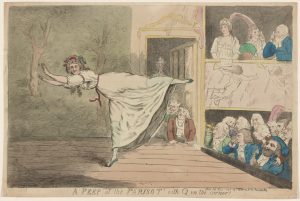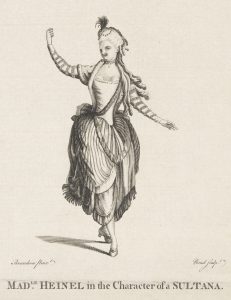Fashionable Society, Ballet and the King’s Theatre, 1770-1800
Currently undergoing redevelopment for publication by Routledge.
[PHD ABSTRACT] “This study examines the alliance between ballet and fashionable culture which enabled ballet to become an integral part of Britain’s theatrical landscape at the end of the eighteenth century. Beginning with ballet’s emergence as a component of theatricalised, sociable entertainments during the 1770s, the study charts the rapid expansion of ballet’s presence in public discourse in the 1780s, and the gradual re-shaping of the beau monde’s relationship with ballet during the politically turbulent 1790s. Central to this project is an emphasis on elite women’s patronage of ballet. As leaders of fashion and social celebrities in their own right, elite women were uniquely able to determine what was ‘in the fashion’, and their patronage of ballet profoundly influenced the status of the art form during this period. Using the methods of cultural history, this study analyses ballet patronage in relation to a variety of categories—gender, elite sociability, constructions of high and low art, national culture and English ‘Francophilia’—to explore the interconnections between shifting modes of patronage and changes to ballet’s reception and representation. Key events during this period provide the backdrop for analysing the evolving alliance between ballet and fashionable society. Among them, Teresa Cornelys’ promotion of theatricalised sociability at her Carlisle House establishment, private entertainments staged by Lord Stanley, the Vestrimania of 1780-81 and the opera house riots of 1789. The influence of evangelicalism is also investigated with reference to the ‘Durham Mustard Affair’ of 1798, sparked when the Bishop of Durham denounced members of the ballet for corrupting the morals of British youth.
While foregrounding women’s engagement with dancers, this research also draws attention to elite men’s patronage of ballet and changing codes of elite masculinity. Emphasising the rhetorical functions of ‘opera girls’ across the period’s print culture, the study offers a new approach to representations of liaisons between noblemen and dancers by locating these relations within a highly adaptable discourse of libertinism. In addition, consideration is given to the ways in which specific categories of masculinity influenced the perceived suitability of ballet as a subject of women’s interest. In the process, this research contributes to understandings of masculinity by drawing attention to the transition from the aristocratic ‘gallant’ libertine of mid-century to the noble ‘sporting libertine’ of the late-eighteenth and early-nineteenth centuries. As a cultural study of elite culture and ballet, this project draws together a large and eclectic range of sources, including correspondence, newspapers and periodicals, graphic satires, novels, clandestine texts, and political and moral tracts. These materials demonstrate that ballet’s association with fashionable culture profoundly influenced the art form’s popularity, its meaning and identity within British culture, and its treatment across diverse fields of popular discourse.”
University of Melbourne, Australia, 2012.

Admired and satirised for her right-angle attitudes, Mlle Parisot was a target of the moral backlash that followed the French Revolution. Illustration by Isaac Cruikshank, 1796. NYPL Digital Collections.
[CONTENTS]
Introduction
Chapter One
Opera-going in Eighteenth-Century London
Chapter Two
Cornelisian Sociability and the Refashioning of Ballet
The Gendering of Fashionable Authority
Chapter Three
The Vestrimania of 1780-81
Ballet d’action and the Expansion of Discourse on Dance
Chapter Four
The Duchess of Devonshire and the Commodification of Fashion
Dance, Masquerade and Exclusivity at the King’s Theatre
Chapter Five
The Opera Girl in Libertine Discourse
Libertinism and the Challenge to Women’s Spectatorship
Chapter Six
Ballet and Political Discourse in the 1790s
The Durham Mustard Affair: Ballet and Libertinism in the Age of Cant

